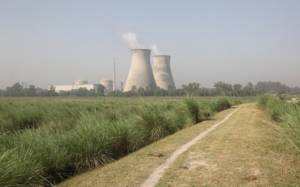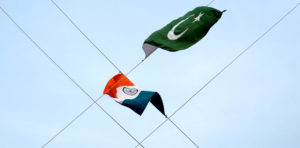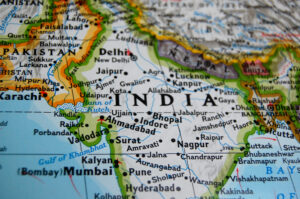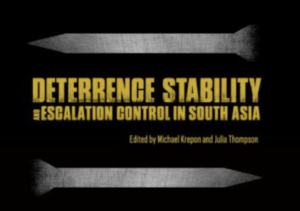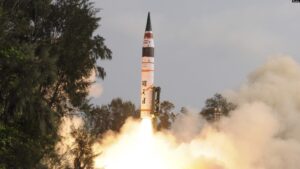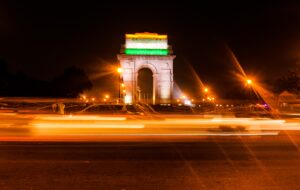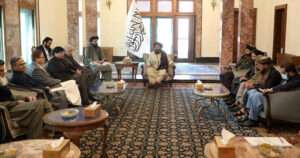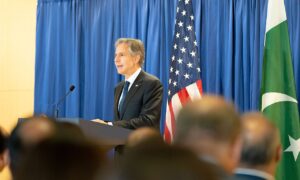1993-2003
1993 to 2003 was a decisive decade in South Asian geopolitics and security that set the stage for today’s regional dynamics. Following the end of the Cold War and the Soviet War in Afghanistan, Washington pursued stronger ties with New Delhi following sweeping 1991 reforms that liberalized India’s economy. It simultaneously limited ties with Pakistan given concerns over its growing nuclear program. In 1998, both India and Pakistan conducted nuclear tests, demonstrating long-suspected capabilities. The next year, the two sides pursued significant engagement only to descend into conflict when Pakistan’s military launched an incursion into Indian-administered Kashmir. The Kargil War marked the first crisis between the two overt nuclear powers and prompted coordinated crisis management efforts between Washington and Beijing.
A second crisis followed soon after with a 2001 attack on the Indian Parliament, which India attributed to Pakistan-based militants. A second terror attack in Jammu and Kashmir brough India and Pakistan to the brink of war. Throughout this period, efforts for peace and dialogue continued intermittently, with occasional setbacks due to acts of terrorism and domestic political challenges in both countries. These events profoundly shaped the India-Pakistan relationship, U.S. engagement in the region, and the broader security landscape in South Asia.
Stimson’s South Asia program is founded and welcomes its first cohort of Visiting Fellows.
Stimson publishes “Crisis Prevention, Confidence Building, and Reconciliation in South Asia,” a collection of recommendations for preventing conflict between India and Pakistan.
India and Pakistan conduct back-to-back nuclear tests (Pokhran-II and Chagai-I). Stimson’s “Strategic South Asia” online course provides a detailed overview of nuclear developments in the region.
Stimson publishes “Aerial Cooperation and Confidence Building,” a collection of essays drawing lessons from the Cold War for tension reduction and conflict management in South Asia.
The Kargil conflict is the first militarized crisis between India and Pakistan following nuclearization. Stimson’s report “The Stability-Instability Paradox: Nuclear Weapons and Brinksmanship in South Asia” offers analysis and recommendations on managing conventional conflict under the nuclear umbrella.
The U.S. reverses sanctions on both Pakistan and India and pursues a fraught partnership with Pakistan to facilitate its war in Afghanistan following the 9/11 terror attacks.
Twin Peaks Crisis threatens all-out war between India and Pakistan over a tense, ten-month period. Stimson’s report, “US Crisis Management in South Asia’s Twin Peaks Crisis,” offers a definitive account of how the crisis unfolded.
Top Research and Analysis
2003-2013
India and Pakistan’s 2003 ceasefire agreement along the Line of Control in Kashmir ushered in an era of engagement between the two sides. Indian Prime Minister Manmohan Singh and Pakistani President Pervez Musharraf built on this momentum with a years-long dialogue process seeking to resolve the Kashmir dispute. However, domestic political developments in Pakistan followed by the 2008 Mumbai attacks, carried out by Pakistan-based militants, closed the door on further progress.
U.S.-India ties flourished following the 2006 landmark civil nuclear agreement, representing a breakthrough in the partnership. Pakistan struggled with a growing threat from militant groups, and pursued counterterrorism cooperation with Washington. The 2011 U.S. raid on Osama bin Laden’s residence in Pakistan was one of several events bringing bilateral relations to a low point, even as Washington sought to invest in Pakistan’s civilian sectors. The 2013 announcement of what became China’s Belt and Road Initiative foreshadowed shifting geopolitical dynamics that would shape the region into the next decade.
India and Pakistan agree to a ceasefire along the Line of Control and international border. Stimson’s 2021 analysis, "Ceasefire On The LOC,” looks back on this milestone following its renewal.
A devasting earthquake hits Pakistan-administered Kashmir, with destruction reaching as far as Islamabad. Stimson’s 2015 analysis, “Cooperation between India and Pakistan after Natural Disasters,” looks at how the disaster impacted regional relations.
The U.S.-India Civil Nuclear Agreement is signed, prompting concerns over its impact on nuclear proliferation in Asia. Stimson’s commentary, “The US-India Nuclear Deal: Another Wrong Turn in the War on Terror,” highlights these challenges.
India and Pakistan sign the Agreement on Reducing the Risk from Accidents Relating to Nuclear Weapons, as Prime Minister Singh and President Musharraf conduct backchannel talks. Stimson’s “South Asia Confidence-Building Measures (CBM) Timeline” details a full list of India-Pakistan CBMs.
The Mumbai attacks, carried out by Pakistani-based terrorist group Lakshar-e-Taiba, risk escalation that is ultimately averted. Stimson’s report, “The Unfinished Crisis: US Crisis Management after the 2008 Mumbai Attacks,” offers a detailed account.
With terrorism surging in Pakistan and the war in Afghanistan raging on, Stimson’s report on “Pakistan’s Nuclear Assets and Threats of Terrorism: How Grave is the Danger?” offers one Visiting Fellow’s assessment of the threat.
Stimson launches South Asian Voices, an online platform for emerging analysts from the region to engage in critical inquiry and free-flowing debate on South Asian affairs.
Top Research and Analysis
2014-2023
The 2014 election of Indian Prime Minister Narendra Modi heralded a more assertive foreign policy for India at a time of converging interests with the U.S. China’s growing involvement in the region, meanwhile, reflected in the 2015 launch of the China-Pakistan Economic Corridor as well as in inroads across maritime and continental South Asia, touched off an era of deepening competition between great powers and their regional partners.
Bilateral tensions between India and Pakistan spiked in 2016, when India responded to attacks on military installations in Indian-administered Kashmir’s Pathankot and Uri with “surgical strikes” across the Line of Control. Another attack on Indian security forces in Pulwama in 2019 prompted India to conduct airstrikes within Pakistani territory and risked escalation with an aerial dogfight between the two nuclear-armed neighbors. The Indian government’s abrogation of Kashmir’s special status that same year further chilled relations. The 2021 U.S. withdrawal from Afghanistan closed a 20-year chapter on America’s direct military involvement in the region, though Afghanistan’s neighbors continue to contend with the fallout from the Taliban takeover. At the decade’s end, deepening geopolitical competition, new regional alignments, and challenges from non-traditional security concerns are key trends driving regional security dynamics, alongside the continued risk of escalation.
Narendra Modi is elected India’s Prime Minister. Stimson’s survey research, “Confidence and Nationalism in Modi’s India,” sheds light on Modi’s popularity and public views on foreign policy issues.
Beijing and Islamabad inaugurate the China-Pakistan Economic Corridor. Stimson’s Visiting Fellow report “The China-Pakistan Economic Corridor: Strategic Rationales, External Perspectives, and Challenges to Effective Implementation,” unpacks its implications.
Attacks on military installations in Indian-Administered Kashmir prompt cross-LoC surgical strikes into Pakistani territory. Stimson’s book, “Investigating Crises: South Asia’s Lessons, Evolving Dynamics, and Trajectories,” offers novel research and analysis into regional crisis trajectories.
Stimson launches the Strategic Learning Initiative, featuring free online courses with regional experts on key strategic and security topics.
The Quadrilateral Security Dialogue is revived among the U.S., India, Japan, and Australia. Stimson’s commentary, “An Evolving Agenda for the Quad,” offers a Visiting Fellow’s analysis on the partnership’s goals and impact.
The Pulwama/Balakot crisis sees India and Pakistan engage in cross-border airstrikes as the role of third-parties shifts. Stimson’s “Regional Roundtable: Reflections on Balakot” features reflections from senior Indian, Pakistani, U.S., and Chinese experts and officials on the crisis.
India ends the constitutionally protected special status of Jammu and Kashmir, prompting protests from Pakistan. Stimson and USIP’s “India’s Kashmir Conundrum: Before and After the Abrogation of Article 370” offers novel research and analysis on conflict dynamics in Kashmir and their implications.
Chinese and Indian forces clash along the Line of Actual Control, resulting in the first casualties in such an event in four decades. Stimson’s “The Challenge of a Two-Front War: India’s China-Pakistan Dilemma” examines India’s border security options and constraints.
India signs the last of four foundational defense agreements with the U.S., deepening the Major Defense Partnership announced in 2016. Stimson’s “Toward a Mature Defense Partnership: Insights from a U.S.-India Strategic Dialogue” outlines opportunities and challenges in the relationship.
The U.S. withdraws its forces from Afghanistan, ending the 20-year war and prompting a Taliban takeover. Stimson and Lawfare’s “The Limits of Leverage in Taliban-Led Afghanistan” details the constraints Washington faces in seeking to shape Taliban behavior post-withdrawal.
Stimson's co-founder Michael Krepon passes, and Stimson publishes "The Gift of Meaningful Work: A Tribute to Michael Krepon," a collection of essays about Michael's life, work, and impact.
Pakistan's monsoon season results in devastating floods that leave one third of the country under water. Stimson's "Climate Change and Conflict Resolution in South Asia’s Highlands" details the growing risk from climate change across the region and outlines potential avenues of cooperation.
Top Research and Analysis
